Key takeaways:
- Classical Chinese Dance is an expressive art that reflects China’s cultural heritage, emphasizing the connection between dancers and audiences.
- Dance competitions foster resilience, adaptability, and discipline, shaping dancers not just in their craft but also in personal growth.
- Emotional growth and self-awareness are significant outcomes of participating in competitions, allowing dancers to confront fears and build community support.
- Receiving critique offers valuable insights for improvement, transforming feedback into a collaborative process that enhances artistry.

What is Classical Chinese Dance
Classical Chinese Dance is a captivating art form that embodies the rich cultural heritage of China. It combines graceful movements, intricate hand gestures, and expressive facial expressions to convey stories and emotions rooted in traditional Chinese beliefs and philosophies. I often find myself mesmerized by how each movement reflects centuries of history, making me wonder about the lives of those who danced before us.
What truly stands out to me is its emphasis on the connection between the dancer and the audience. This dance form uses rigorous techniques that not only showcase physical skill but also invite viewers into a deeper emotional experience. I remember my first encounter with a live performance; the dancer’s fluidity and poise transported me to another era, as if I were witnessing a tale unfold right before my eyes.
The training for classical Chinese dance is equally remarkable. Dancers spend years honing not just their physical abilities but also their understanding of music, poetry, and visual arts that complement the dance. It makes me reflect: how does such dedication shape not just the dancers, but also the way we perceive this ancient art form? Each performance feels like a dialogue, bridging the past and present in a stunning expression of cultural identity.
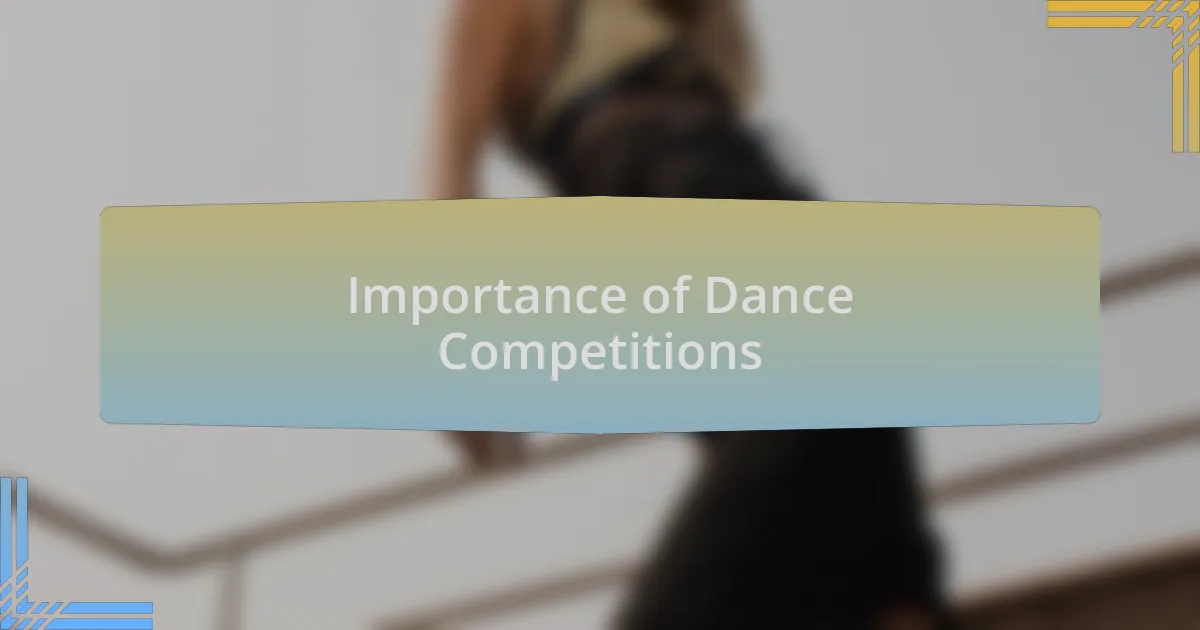
Importance of Dance Competitions
Dance competitions play a pivotal role in the development of dancers, fostering a spirit of challenge and ambition. I remember preparing for my first competition with a mixture of excitement and anxiety. The pressure to perform pushed me to refine my technique and artistry, ultimately leading to growth that I wouldn’t have experienced outside that competitive environment.
Participating in these events also opens doors to valuable feedback. After one competition, a judge pointed out nuances I had overlooked in my performances. While it stung to hear, it was also enlightening. Such critiques offer insights that help reshape our approach, not just as dancers, but as artists striving for a higher standard.
Moreover, the camaraderie and connections formed among competitors enrich the dance experience. I often left competitions with not just trophies, but friendships that fostered a shared passion for our art. Reflecting on these moments makes me appreciate how competition cultivates a vibrant community, encouraging us all to elevate our craft while supporting each other along the way.
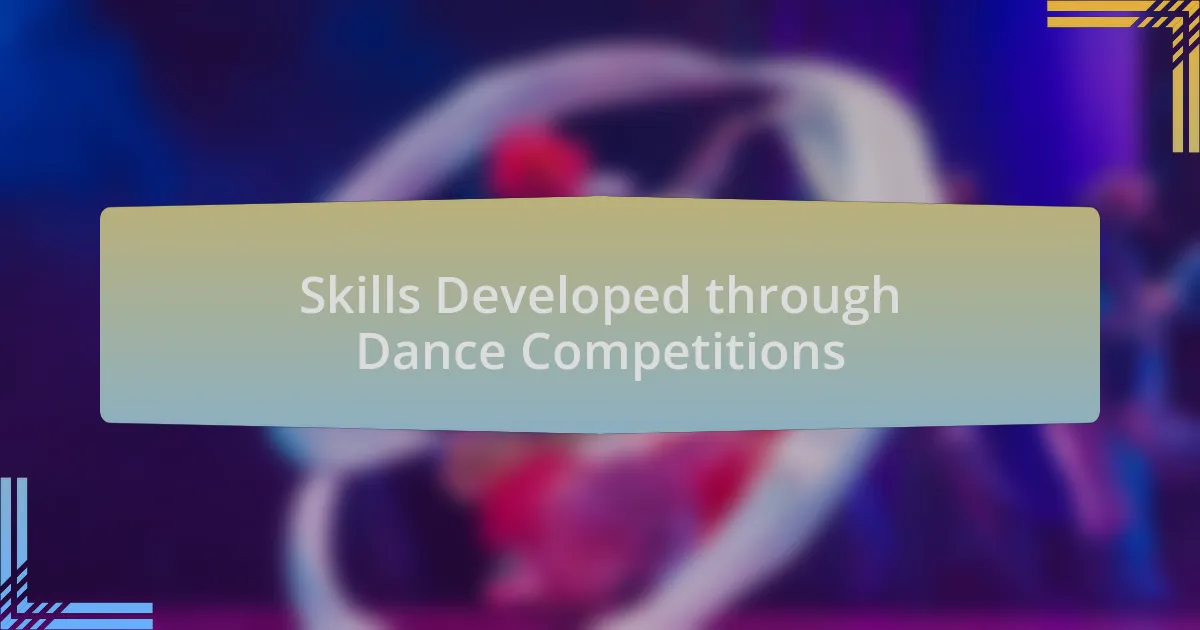
Skills Developed through Dance Competitions
Competing in dance taught me the importance of resilience. I vividly recall a moment when I stumbled during my routine, feeling the heat of embarrassment wash over me. Instead of giving up, I learned to regain my composure and push through the performance. That experience showed me that failure can lead to strength, a skill I’ve applied in many facets of life beyond dance.
Another essential skill developed through competitions is adaptability. I often found myself in situations where the unexpected happened, whether it was a last-minute change in music or a competitor’s style that inspired me to shift my approach. Navigating these challenges taught me to be flexible, reminding me that growth often arises from stepping outside my comfort zone.
Lastly, the discipline required in preparing for competitions has shaped my work ethic. Every hour spent rehearsing fueled not just my dance technique but also my ability to set and achieve goals. Reflecting on my journey, I can see how this commitment influenced my other interests—proving that dance competitions cultivate not just dancers, but dedicated individuals ready to tackle any challenge.
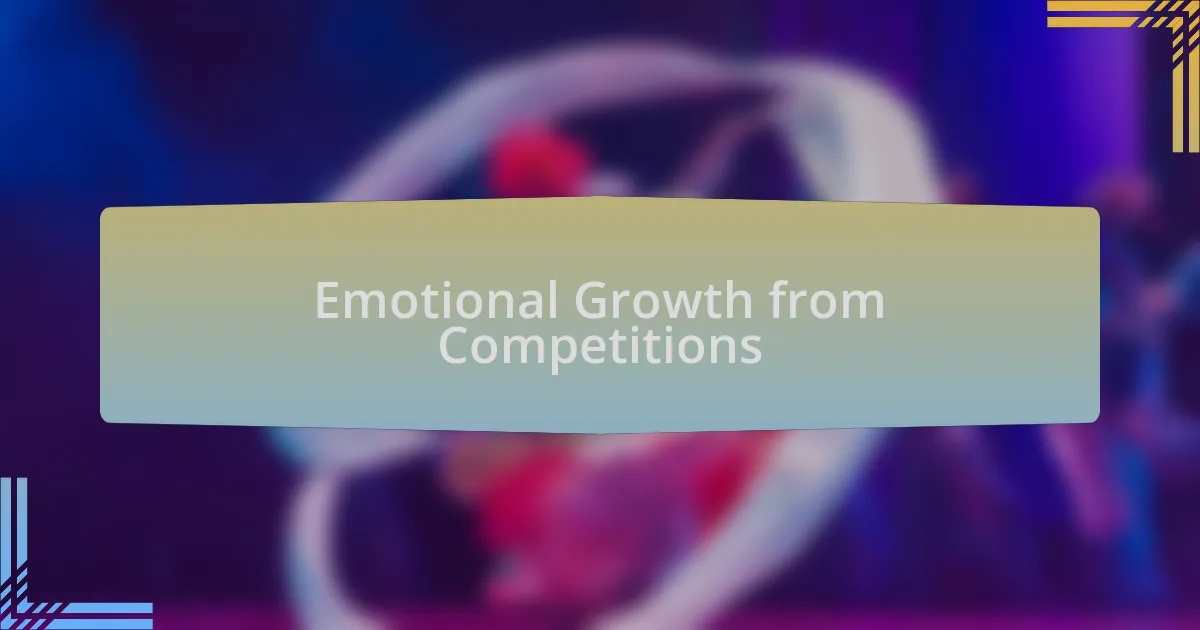
Emotional Growth from Competitions
Emotional growth during dance competitions has been as transformative as mastering any technical skill. I remember standing backstage, heart racing, drowning in a sea of doubt. It struck me that while competition can be intimidating, it also pushed me to confront my fears and acknowledge my feelings, fostering a deeper self-awareness that I still carry today.
The pressure of performing in front of judges and peers can feel overwhelming, but I found it a powerful catalyst for emotional resilience. After one particularly challenging competition, I realized that the disappointment of not placing as I had hoped didn’t define my worth. Instead, it became a vital lesson in self-acceptance, teaching me that my passion for dance transcends scores and accolades.
Moreover, the camaraderie forged with fellow dancers has been an incredible source of emotional support. There were moments when we shared our anxieties and triumphs, reinforcing the idea that I wasn’t alone in this journey. Isn’t it fascinating how shared experiences can create bonds that uplift us all? Through these connections, I learned to appreciate the beauty of vulnerability, which ultimately enriched my emotional landscape.
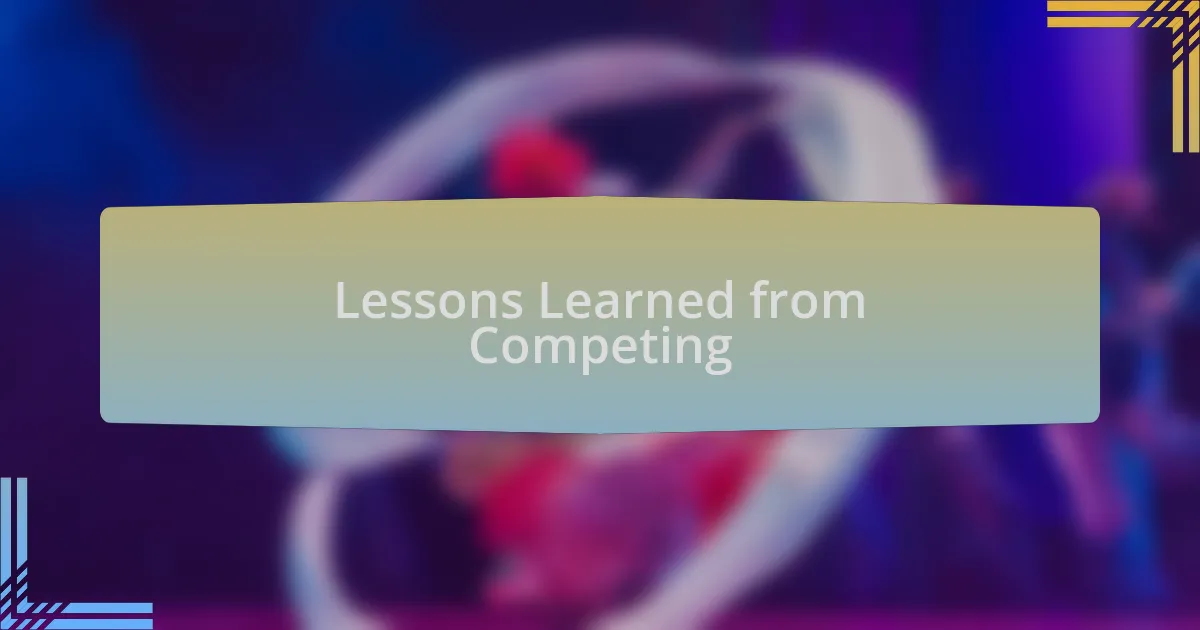
Lessons Learned from Competing
Competing in dance taught me invaluable lessons about discipline and commitment. I vividly recall a moment when I was preparing for a major competition; I almost considered skipping rehearsals due to fatigue. Yet, as I pushed through those doubts, I realized that this dedication not only improved my performance but also instilled a sense of pride in my work ethic. How could something so demanding yield such personal rewards? The answer lies in the growth that comes from embracing challenges head-on.
Another crucial lesson was the importance of adaptability. I remember during one competition, my music abruptly stopped mid-performance. Instead of panicking, I took a deep breath and improvised, responding to the unexpected turn with grace. This experience taught me that moments of uncertainty can lead to creativity and innovation. How often do we let fear of failure hold us back from showcasing our true potential? I learned that by embracing the unknown, I could discover new avenues in my artistry.
Lastly, I’ve come to appreciate the power of feedback from judges and peers. Initially, I dreaded criticism, fearing it would undermine my confidence. However, as I accepted constructive feedback, I found it enlightening. It encouraged me to view my performances through a different lens, shaping my style and technique. Isn’t it amazing how feedback can transform our perspective? By remaining open to growth, I realized that the journey of dance isn’t just about perfecting moves, but also about continuous improvement and exploration.
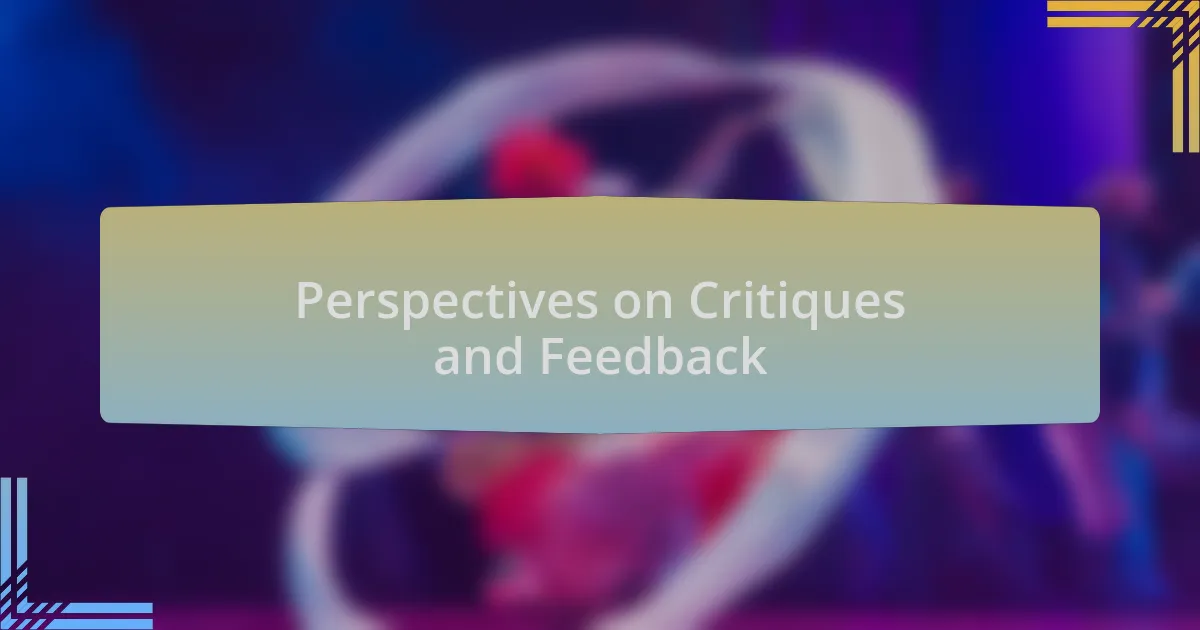
Perspectives on Critiques and Feedback
Receiving critiques can feel daunting at first, but I’ve learned that they are golden opportunities for growth. I remember one instance when a judge pointed out the need to enhance my emotional expression during a performance. At first, I felt defensive, but I later realized this feedback was not a rejection but rather an invitation to dig deeper into my artistry. Don’t you think that sometimes the most uncomfortable critiques can lead to the most profound breakthroughs?
It’s interesting how feedback can shape our perspective on our own abilities. After a particularly challenging competition, a fellow dancer told me that her judges had noticed my precise movements but suggested I connect more with the audience. I took this feedback to heart and started focusing on making eye contact and emoting through my body language in every practice session. This experience made me wonder—what if I had dismissed that critique? It truly highlighted the importance of seeing feedback as a bridge, not a barrier, to improvement.
Now, I’ve come to appreciate that feedback is a collaborative process. During rehearsals, I often engage in discussions with my peers about our performances, sharing insights and suggestions. This camaraderie fosters a space where everyone feels safe to grow. I’ve found that asking my fellow dancers how they perceive my interpretations opens my eyes to new dimensions in my work. Isn’t it fascinating how we can learn from each other, turning critiques into stepping stones for collective success?

Personal Experiences and Insights
It’s incredible how dance competitions have shaped my understanding of perseverance. One time, after a particularly grueling performance, I stumbled and felt the weight of disappointment. But as I approached the judges’ table, ready to hear my scores, I noticed my peers supporting each other, sharing their own fears and triumphs. It dawned on me that this community thrives on shared experiences. Have you ever felt uplifted just by knowing others share your struggles?
In another competition, I remember feeling absolutely in tune with my body, the music flowing through me like a current. When I received accolades for that performance, it struck me that it wasn’t just about technical precision. It was this profound connection to the art that truly resonated with the audience. Have you experienced that moment where everything clicks and feels effortless? Those moments are what fuel my passion for dance and remind me why I keep pushing forward.
There’s also a unique joy in watching young dancers find their footing. At one event, I mentored a newcomer who was terrified to perform solo. I remember her face lighting up after she completed her routine, filled with exhilaration. It made me reflect on how every dancer’s journey is a blend of anxiety and triumph. Isn’t it rewarding to see someone blossom through their own experiences, reminding us all of the beauty in vulnerability?